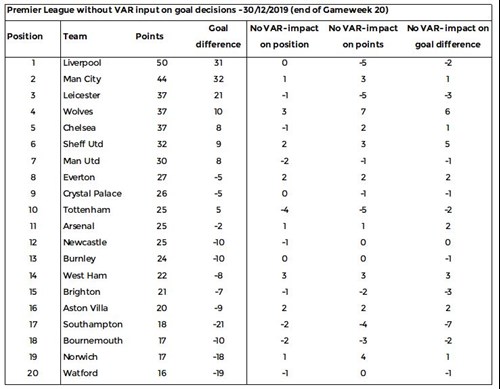By Christopher Winn, Programme Leader for MSc Football Business
As 2019 draws to a close and the Premier League enters the second half of the season, the debate of choice continues to be that of VAR and its appropriate application to the game.
Indeed, while the International Football Advisory Board have recently repeated the fact that VAR technology exists only to reverse ‘clear and obvious’ mistakes, we have seemingly progressed to a point whereby every goal is investigated for offside to the nearest millimetre by the VAR team- far from the definition of clear and obvious, and undermining the presence and purpose of the on-pitch referee team.
Furthermore, unlike in other top European leagues, Premier League referees are not utilising the on-pitch monitors, further inhibiting the on-pitch transparency of VAR decisions made.
While it will obviously take time to iron out the VAR process and its relevant application, we thought it would be a good time to update our VAR-less Premier League table, to understand after 20 rounds of games exactly who has benefited and equally suffered most for the introduction of VAR when it comes to goal related decisions.
While this is no exact science, there is clear evidence that all those armpits, shoulders and shoelaces are starting to materially affect the fortunes of some teams more than others, most notably at the top of the table.

- We calculate that VAR goal decisions have influenced the overall result of matches, or the number of goals scored, in 44 of the 199 Premier League games played to date- 22% in total.
- Liverpool, Leicester and Tottenham have all benefited the most in terms of points gained via VAR goal decisions as at the end of game week 20, with each being five points better off than they would have been without VAR. This also contributed to Tottenham falling from 6th to 10th in the VAR-less table, the greatest fall of any team.
- Combined with Man City gaining three points in the VAR-less table, the gap at the top would be reduced from 13 points to just 6 points, with Man City replacing Leicester in 2nd place.
- Wolves are the team to have suffered the most through VAR goal decisions, gaining an additional seven points and rising three positions to 4th place in the VAR-less table. It’s no coincidence Wolves are also the team to see their goal difference improve the greatest without VAR, rising by six goals to a goal difference of 10.
- Southampton’s goal difference would fall the greatest - seven goals to -21 - were it not for VAR goal decisions, resulting in a fall of two places and four points in the VAR-less table.
- Without VAR, Norwich and Watford would remain in the bottom three, however Bournemouth would replace Aston Villa in 18th as a result of losing three points otherwise gained through VAR.
- Newcastle United are the only Premier League team to have not been directly affected by a VAR goal decision in terms of points gained or goal difference.
- Of the 20 game weeks so far in 2019/20, only one (week 4) has featured a full round of games where VAR has not overruled a goal decision- although it has since been admitted that VAR should have intervened in one game that week but failed to do so.
As such with the business end of the season on the horizon, it won’t be long before we are able to translate these table differentials into the cost or benefit when it comes to Premier League financial distributions.
Until then, VAR will most likely remain in its current form until the end of the season at the earliest, much to the frustration of the majority of players and fans alike.
















